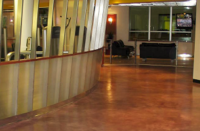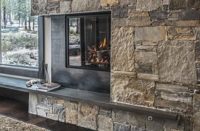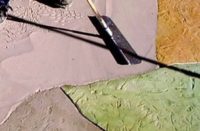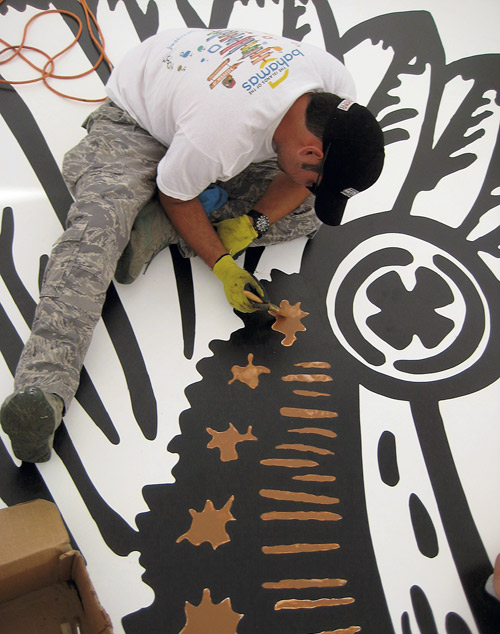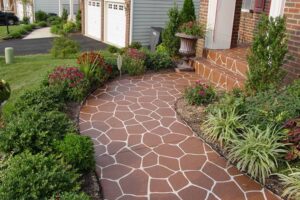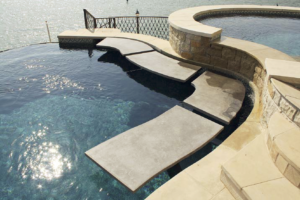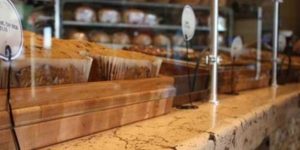When he first set out to make his way in the construction business, Carlos Perez didn’t really figure on decorative concrete as his career path.
But once he took a detour in that direction, it proved to be a wise change of course.
At just 34 years old, Perez is the owner and manager of Custom Concrete Designs Florida, in West Palm Beach. The relatively new business is making its mark in South Florida and beyond. Perez is capitalizing on his South American origins and connections to do business in Central and South America in addition to his Floridian home base.
Perez came to South Florida by way of New York City, where he moved in 2000 from his native Colombia. He worked as a remodeling subcontractor in Gotham before relocating to West Palm Beach and starting up a remodeling business there in 2002.
In West Palm Beach, Perez took note of the growing popularity of polished concrete and other decorative concrete applications. He had seen examples of the polishing process, but was not familiar with it first hand. That changed when a remodeling customer asked if Perez would polish the concrete in the garage of his upscale home.
One thing led to another, as they say, and Perez soon experienced the gravitational pull of decorative concrete as a powerful force in his career trajectory.
Not that the journey has gone without a hitch. Perez’s initial foray into the trade didn’t pan out as he’d expected, as a partnership with a supplier of polished concrete materials and equipment didn’t hum along so smoothly.
Undeterred, Perez in 2009 decided to fly solo and start Custom Concrete Designs FL, propelled by emerging opportunity in the decorative concrete field. The potential was apparent in the high-end residential segment that was a major part of his remodeling business, he says. Customers of his remodeling work increasingly inquired about decorative concrete, asking Perez to take on those types of jobs.
Perez says that while he has learned the science of decorative concrete on the job — with a great deal of help from materials experts and industry programs — he brings an eye for art and design to the work too.
“I come from a family of artists,” he says. His mother taught art in school and operated an arts and crafts shop as well. Later, attending Saint Thomas University in Colombia, he used his talent for art in the creation of projects and models in construction classes.
“I was always coming up with new ideas. Even with my remodeling company, I was doing creative things with paint and finishes, and I moved that into concrete. I’m 100 percent sure I don’t know it all, and I am always learning. I go to shows and share knowledge with other guys, and I combine techniques and come up with different things.”
He says knowing the technology and the materials is crucial as a foundation. “You can have the skills, but if you don’t know the ingredients for the cake, it’s not going to taste good.”
Seizing the opportunity
While the deal with the polished concrete partner didn’t take off, the brief business venture did provide an introduction to the decorative concrete community and key suppliers. Overlay products and systems have been particularly important as a key growth driver for his company, Perez says.
“With overlays, you have a variety of decorative options,” he says, listing aggregates, terrazzo finishes, integral color, stains and other treatments as options with cementitious materials of this type.
Also proving a good sell in retail outlets are microtoppings, where a hard-troweled look can be produced with multiple layers of the material and a urethane sealer, Perez says.
“People love that marbleized, Venetian plaster kind of look,” he says.
The company’s portfolio bulges with imaginative uses of color and decorative effects — colored and terrazzo overlays with 3-D stencil designs and the use of a wide variety of aggregates, including conch shells, granite, petrified wood, colored glass and glow-in-the-dark seedings. The portfolio extends to precast exterior cladding panels and countertops, polished concrete, stamps, stencils and various types of repair and restoration.
Perez credits a trio of project foremen — Fabio Castillo, Giovanni Calix and Garemias Quinonez — with playing pivotal roles in the company’s success. All are expert in facets of the decorative and restoration trades, he says. Castillo is particularly skilled in concrete polishing, while Calix and Quinonez focus more on decorative stamping, microtoppings and precast materials. The company’s employee ranks now stands at 12 people.
Custom Concrete Designs is also beginning to build an international portfolio, with jobs in Perez’s native Colombia and in Panama. These projects are more industrial in scope — warehouse, factory and parking-garage repair and restoration work.
“There are good opportunities there,” he says of South and Central America. “There is a lot of competition in Florida and America in general. The competition is less down there, and there are fewer companies with these capabilities. It’s a good market and opportunity for us.”
Demanding projects
One recent, notable project that put Custom Concrete Designs’ emerging range of capabilities to the test involved a two-story structure in Miami’s Design District. The company addressed imperfections in the exterior poured-in-place concrete exterior — left by formwork — with patching and application of a thin microtopping and protective sealer. The company also collaborated with a metal subcontractor to produce integrally colored concrete and steel composite-panel box inserts for the building’s window fenestrations. The job demanded precision in production and installation, as the rectangular frames each measured approximately 4 feet wide by 13 feet high and weighed 1,700 pounds.
Custom Concrete Designs faced a formidable task of a much different type at a SABMiller brewery in Medellin, Colombia, where the company was summoned to formulate and execute a repair and restoration program for seriously damaged and degraded concrete floors. First there was the challenge of selling facility managers on the need to invest in effective solutions. These measures included extensive repairs to damaged concrete around expansion joints, heavy shaving and grinding of the flooring, and use of high-performance repair materials and diamond grinding and polishing.
Perez says his company was approved for the job after the client sent a plant engineer to have a look at a massive floor-restoration project executed by Custom Concrete Designs at a flower warehouse in Miami — a grind-and-polish job using a colloidal silica densifier and high-performance polyurethane sealer.
Aside from the scope of the technical challenges of such a massive repair and restoration assignment, the SABMiller project offered a stark lesson on the most basic aspects of doing business in a developing economy.
“It’s not like America where everything is easy to get, just by walking into a Home Depot,” he says. “It was impossible for us to get a 6-inch scraper” — the simplest of hand tools. This had to be express-shipped from Florida, along with other materials and equipment for the job.
Nonetheless, he says, “It’s exciting to expand my business to my home country. I don’t call it headaches, I call it challenges.”
Limitless variety
No matter the geographic location, Perez says educating the customer is the heart of his credo.
“Don’t hesitate to explain how you build things,” he says. “This will allow you to explain how things can go wrong, what it takes to do things right.”
This mandate extends to working with designers as well, most of whom get their ideas from glossy publications that serve up exquisite images of concrete artistry, but don’t carry a disclaimer that actual results may vary.
“They need to know how that gets built, how it gets done,” he says. “We are manufacturing at the job site, not with a machine where you can control everything. It’s a little more tricky for us, with temperature, humidity and other conditions. If you are only focused on selling the job, and don’t educate the customer, a lot of things can go wrong.”
